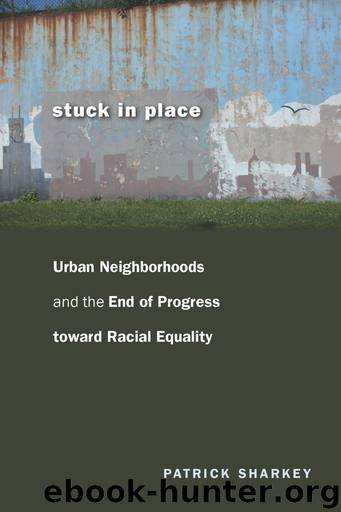Stuck in Place: Urban Neighborhoods and the End of Progress toward Racial Equality by Patrick Sharkey

Author:Patrick Sharkey [Sharkey, Patrick]
Language: eng
Format: epub
Tags: USA, Geografia
Publisher: University of Chicago Press
Published: 2013-05-14T22:00:00+00:00
Figure 5.5. Statistically adjusted scores on tests of broad reading skills and applied problems skills, by neighborhood poverty status over two generations.
Considering the overall patterns present in figure 5.5, two results stand out. First, while research examining how neighborhoods affect children’s outcomes has focused exclusively on the child’s own environment, there is very strong evidence suggesting that the parent’s childhood neighborhood, experienced a generation earlier, is at least as important to the development of cognitive skills—and in the case of the applied problems assessment, the evidence suggests the parent’s environment during childhood may be more important than the child’s own environment. Second, the multigenerational impact of neighborhood poverty is substantial. Living in poor neighborhoods over two consecutive generations reduces children’s cognitive skills by roughly eight or nine points on the standard IQ scale, or slightly more than one half of a standard deviation.
To provide some perspective on the magnitude of this estimated effect, it may help to consider some estimated effects of other factors that are thought to be related to intelligence or cognitive ability. For example, in 2007 a study was published showing that firstborn children had higher IQs than their second-born siblings.16 The study received an enormous amount of attention in the press and scrutiny in the academic world, as it purported to show strong evidence that firstborn children were smarter than their siblings. With all of this attention, the magnitude of the estimated difference between firstborn children and their siblings was about three points on the same scale that I am using for the current analysis. The cumulative impact of neighborhood poverty is about three times as large as the “firstborn” effect.
Another, perhaps more relevant example is the effect that schooling has on children’s cognitive ability. After considering the literature on this subject, Christopher Winship and Sanders Korenman concluded that a year of schooling improves children’s cognitive ability by somewhere between two and four points.17 This means that the effect of being raised in a family that lives in a poor neighborhood over two consecutive generations is roughly equivalent to missing two to four years of schooling.
The Legacy of Disadvantage
The magnitude of the effects of multigenerational neighborhood poverty is striking. But just as important as the size of the effects is their meaning. If nothing else, this analysis demonstrates that the full impact of neighborhood inequality cannot be captured by looking at a single point in a child’s life or even at a single generation in a family’s history. In chapter 2, I showed that the large majority of African American families living in today’s most disadvantaged residential areas are the same families that occupied the most disadvantaged neighborhoods in the 1970s, raising the possibility that we may be missing something important if we fail to consider the history of families’ environments, or if we fail to think about neighborhood disadvantage as a multigenerational process. This chapter shows just how important that history can be.
Thinking about neighborhood environments in this way complicates the way we study and assess the impact of neighborhoods on individuals.
Download
This site does not store any files on its server. We only index and link to content provided by other sites. Please contact the content providers to delete copyright contents if any and email us, we'll remove relevant links or contents immediately.
| African-American Studies | Asian American Studies |
| Disabled | Ethnic Studies |
| Hispanic American Studies | LGBT |
| Minority Studies | Native American Studies |
Cecilia; Or, Memoirs of an Heiress — Volume 1 by Fanny Burney(32022)
Cecilia; Or, Memoirs of an Heiress — Volume 3 by Fanny Burney(31436)
Cecilia; Or, Memoirs of an Heiress — Volume 2 by Fanny Burney(31380)
The Great Music City by Andrea Baker(30641)
We're Going to Need More Wine by Gabrielle Union(18605)
All the Missing Girls by Megan Miranda(14592)
Pimp by Iceberg Slim(13717)
Bombshells: Glamour Girls of a Lifetime by Sullivan Steve(13665)
Fifty Shades Freed by E L James(12886)
Talking to Strangers by Malcolm Gladwell(12813)
Norse Mythology by Gaiman Neil(12785)
For the Love of Europe by Rick Steves(11331)
Crazy Rich Asians by Kevin Kwan(8860)
Mindhunter: Inside the FBI's Elite Serial Crime Unit by John E. Douglas & Mark Olshaker(8664)
The Lost Art of Listening by Michael P. Nichols(7125)
Enlightenment Now: The Case for Reason, Science, Humanism, and Progress by Steven Pinker(6852)
The Four Agreements by Don Miguel Ruiz(6284)
Bad Blood by John Carreyrou(6255)
Weapons of Math Destruction by Cathy O'Neil(5801)
